Photographing the Myth of the West Village Girl
A visual study of formation, spectacle and self-curation
Welcome to In the Flash, a weekly, behind-the-lens dialogue on photography. To join the conversation
This April, I spent four weeks circling Christopher, Hudson, and Bleecker streets, looking for West Village girls for a cover of New York Magazine. The first challenge of this tricky shoot was identifying who fit the profile written by Brock Colyer.
These were the visual markers I was looking for.
20-year-old somethings
Long, straight, preferably blonde hair
Traveling in packs of at least three
Packs worked best if they were wearing the same uniform, light blue jeans/white t
Day-drinking Aperol spritzes
My biggest concern was to avoid misrepresenting someone as a West Village girl — a title that some would find contentious. A few young women that I approached didn’t want to be photographed and labeled as, one told me, “basic bitches,” while others were thrilled to be included. Somewhat ironically, many of the groups who were happy to be photographed didn’t actually live in West Village or Manhattan, traveling to the neighborhood from Hoboken, a quick PATH train away.
The trend of the West Village girl is a delicate mix of fantasy and reality. There are flocks of 20-somethings walking around in identical outfits not just in the neighborhood but all over New York City. We’ve all seen them. But the article refers to a specialized variety of this young woman, one on top of the pecking order, a high-power girl boss working in marketing, PR, tech, or finance, while flaunting a highly social, image-conscious lifestyle on social media. In other words, an influencer. The ones who do actually live in West Village come with another unspoken factor, wealth, since the neighborhood is notorious for being one of the most expensive real estates in the city.
So, I had to add another factor to my roster of visual clues.
The glossy rich girl look
Though the fantasy they perpetuate on TikTok and Instagram gives West Village the feel of a vast, luxurious sorority, such young women were difficult to spot in the sea of tourists and families crowding the neighborhood on sunny weekends. I realized that I was looking for crumbs of their mythical world colliding with the outdoor seating at West Village’s trendiest cafes, and besides the impossibly shiny hair and expensive sunglasses, the number one signifier of the West Village girl had to be iPhones pointed at each other. And, just like that, I followed the phone.
Which led me to the group sitting outside Hudson Hound, displaying all the appropriate swag with the addition of preppy yellow sweaters that would feel more appropriate in the Upper East Side or Connecticut than in any of the Villages. They seemed perfect. It turned out that my instincts were right; one of the young women happened to be the daughter of a Rich Housewife and all of them happily identified with the tag of the West Village girlie.
The biggest pitfall I was preparing myself for while singling out young women for the article was the amount of criticism they could receive from the anonymous and judgmental public. A young, beautiful, blonde, heterosexual female influencer residing in West Village is the second easiest target after a heterosexual finance bro living in Murray Hill.
I know this from personal experience. When I photographed young women going out in the Meatpacking District more than a decade ago, the photos received a good amount of resentment and mislabeling. People felt triggered by women in short skirts and high heels, scapegoating their escapades as the end of civilization, which, for New Yorkers, ironically means bemoaning the gritty, uncivilized past of the city. One unscrupulous article in Italian Vanity Fair went a step further, publishing the project with writing about high-end prostitution in the Meatpacking District.
Now, ten years later, I was hunting for the next generation of women having a great time in a neighborhood just a few blocks down from Meatpacking. I wanted the photos to poke a bit of cheeky fun at the picturesque West Village girl, albeit with kindness. The images had to deconstruct the trend without either demeaning the young women portrayed or flattering them.
In the end, the West Village girl isn’t a person so much as a lifestyle package and a performance, a sunlit loop of content, beauty, and brunch. Whether or not this young woman resides in the neighborhood is almost beside the point. She lives in an algorithm by representing a kind of aspirational femininity — polished, apolitical, and highly visible. All of that makes her an easy target for public ire. As I found out through my previous projects like Bachelorette or Meatpacking, it’s easy to dismiss young women enjoying themselves in public, especially if they are doing it in matching outfits.
There is nothing cryptic about the West Village girl. She embodies a version of youth that feels frictionless, almost corporate in its branding. What she is not, however, is basic. That’s part of what makes her compelling, she’s mastered the aesthetics of self-presentation without the burden of justification. She is not performing complexity, and in a culture thriving on micro-analysis and virtue signaling, that can read as naive. But it’s a choice. Young women have always been, and will always be, scrutinized for what they do or don’t do, what they wear, and what they say or don’t say.
The West Village girl is just a young woman out for drinks with her friends, but what makes her fascinating is the self-made fantasy she curates online, so alluring that it’s hard to tell where the performance ends and real life begins. This visual narrative became a kind of myth, and when I was photographing, I had to extract it from the clutter of the everyday. I wasn’t really looking for specific women, but for the modern It Girl, Clueless’ Cher Horowitz with a TikTok account.
As if.
I was also tracking patterns, the geometry of long, straight hair, and the choreography of blue jeans. The repetition didn’t flatten the young women, it gave them structure, using social formations as a kind of public language of the youth culture. I watched groups of women settling into poses that, shaped by social media, were effortlessly photogenic. And I was envious of them. My twenties weren’t nearly as coordinated.
I live in East Village, and it’s full of the same 20-somethings spilling out on the sidewalk of Saint Marks in a vast sea of blue jeans and cropped tops, an Aperol spritz in hand. This is a city uniform signaling a generation. The West Village girl is less of a person than a system, a cultural object that refuses to dissolve under scrutiny.
I photographed this group of women outside of a buzzy West Village cafe, and they happened to find their photo on my Instagram.
“That’s me and my friends outside of Roeys!!!,” one of them commented, “And fun fact we are Hoboken girls. LOL!”
It Must Be Nice to Be a West Village Girl, by Brock Colyer
Find me on Instagram, @dina_litovsky


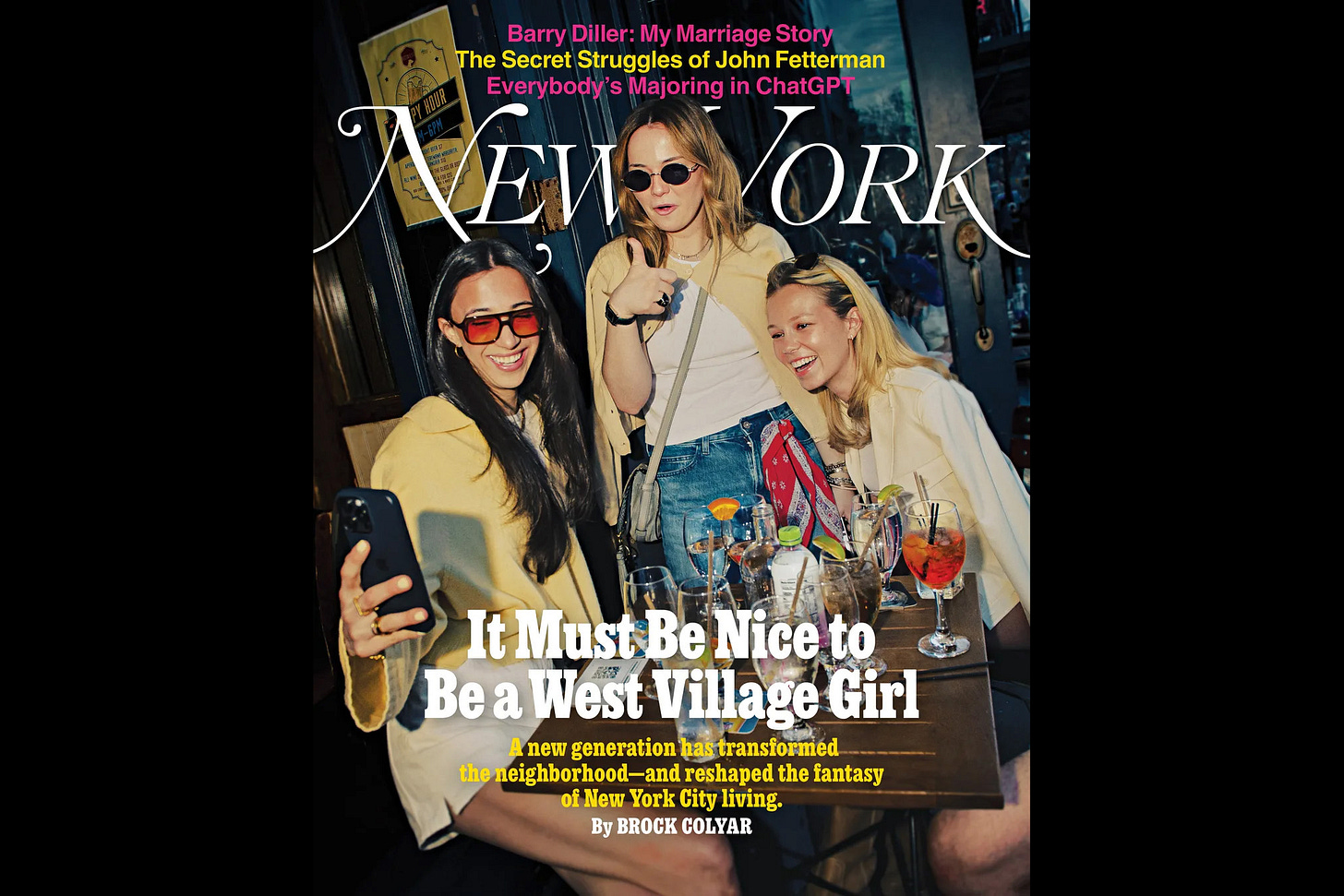
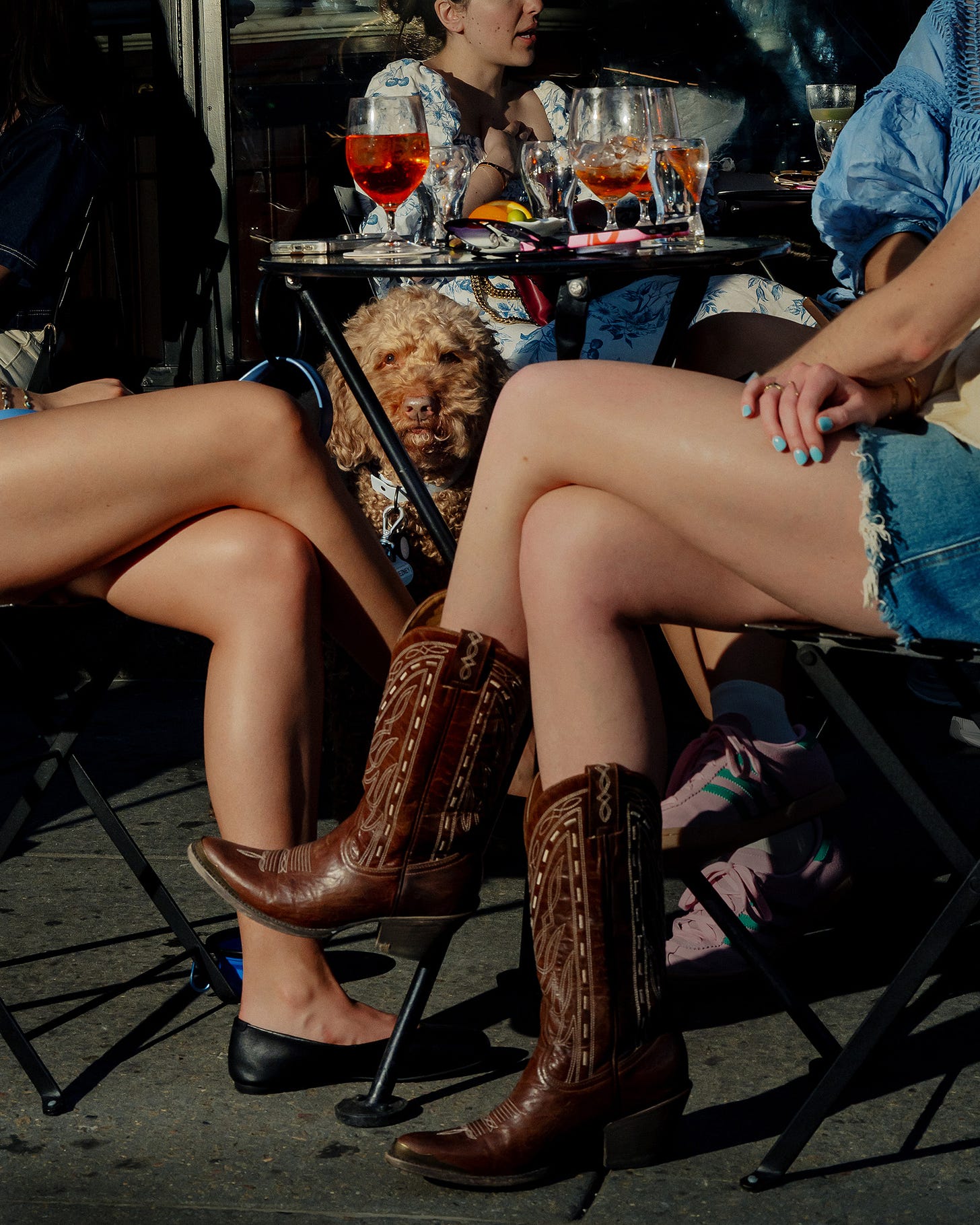
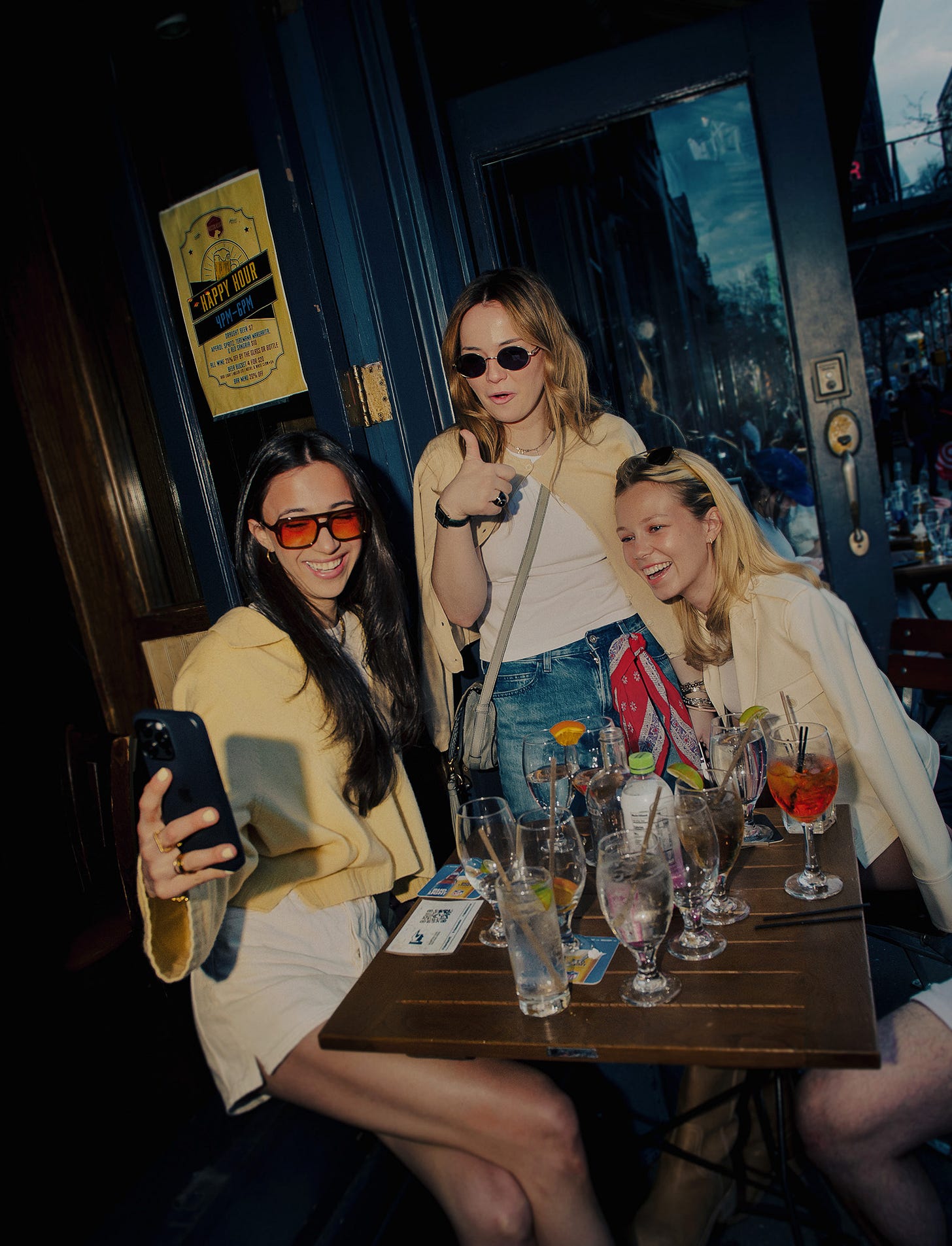
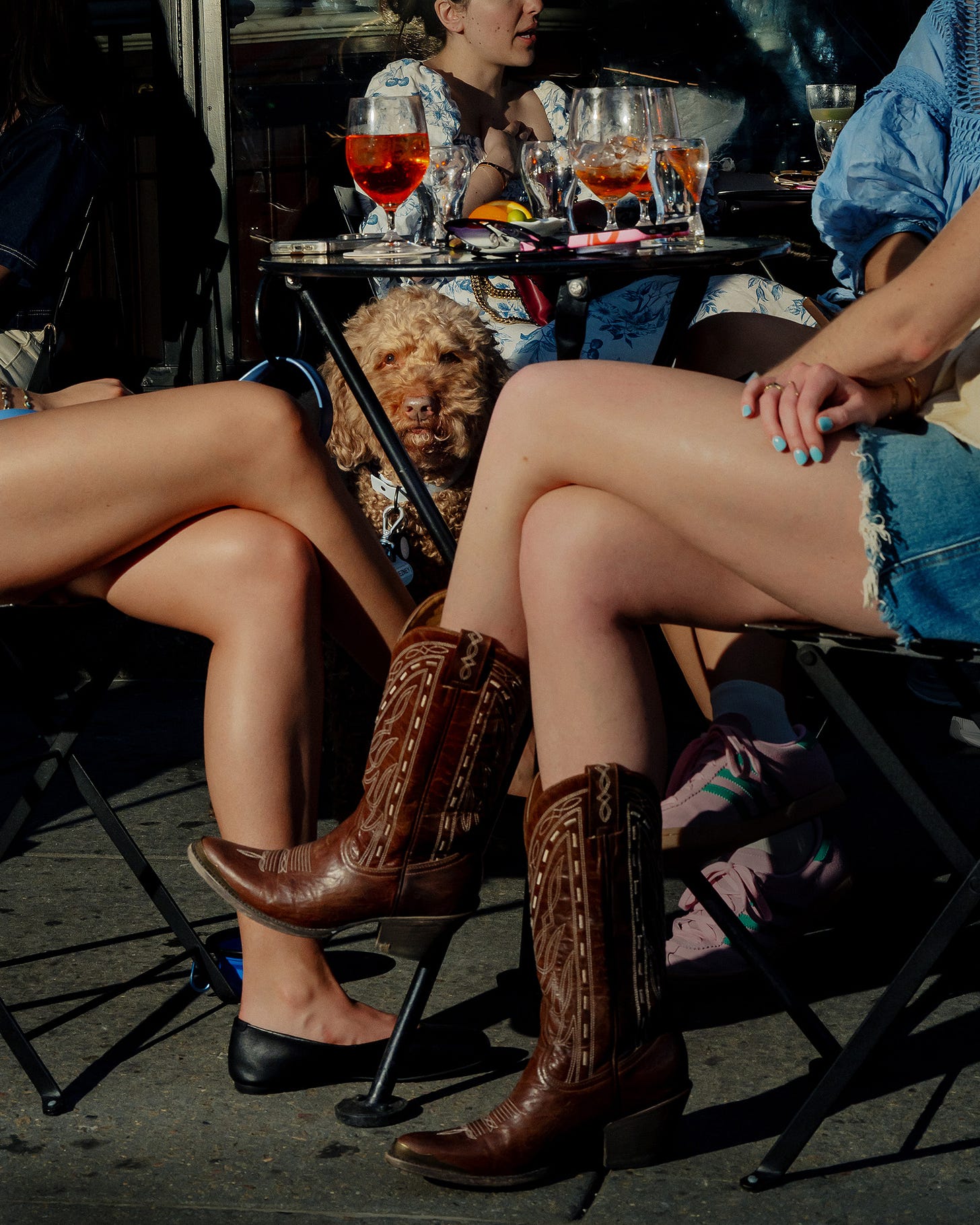
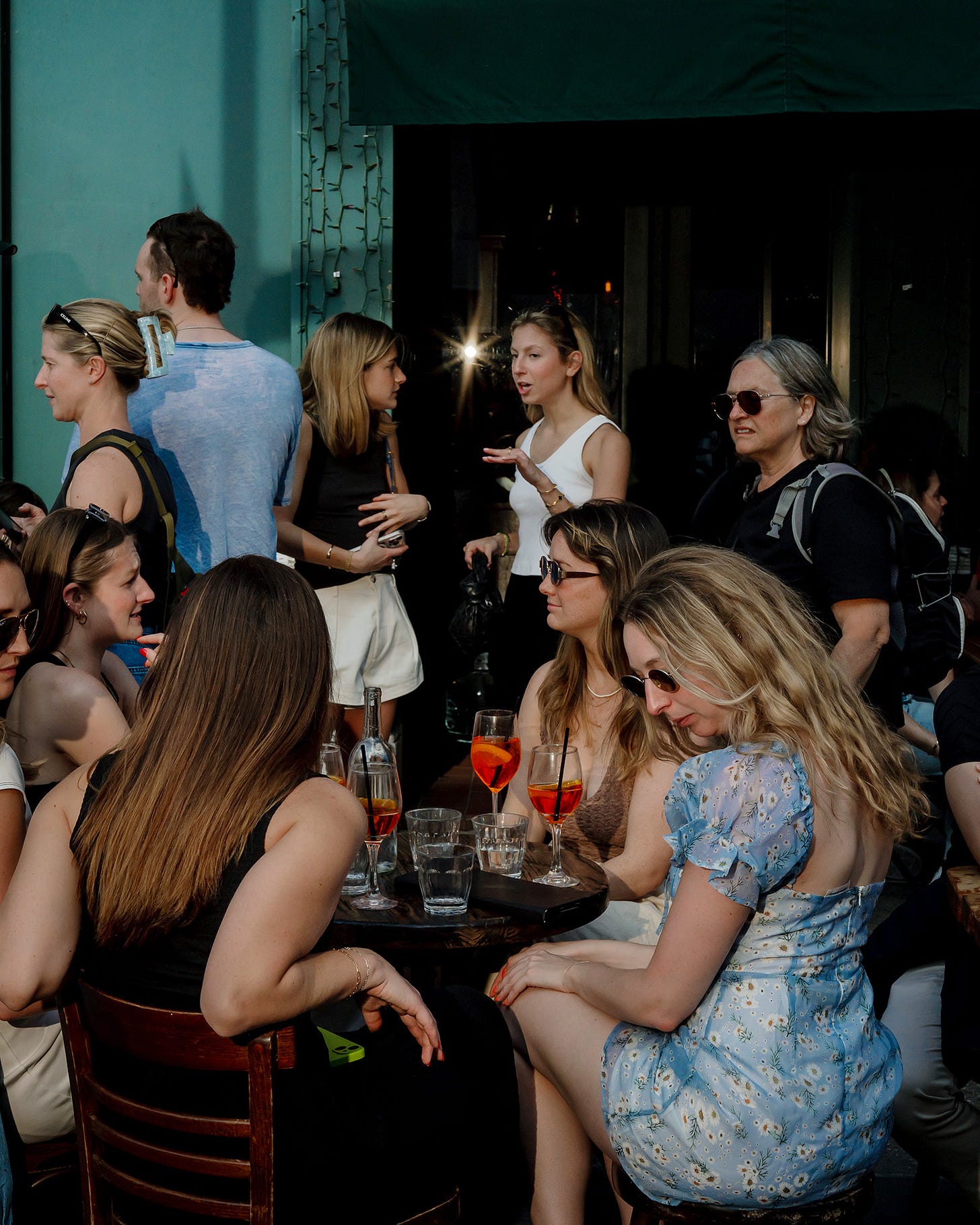
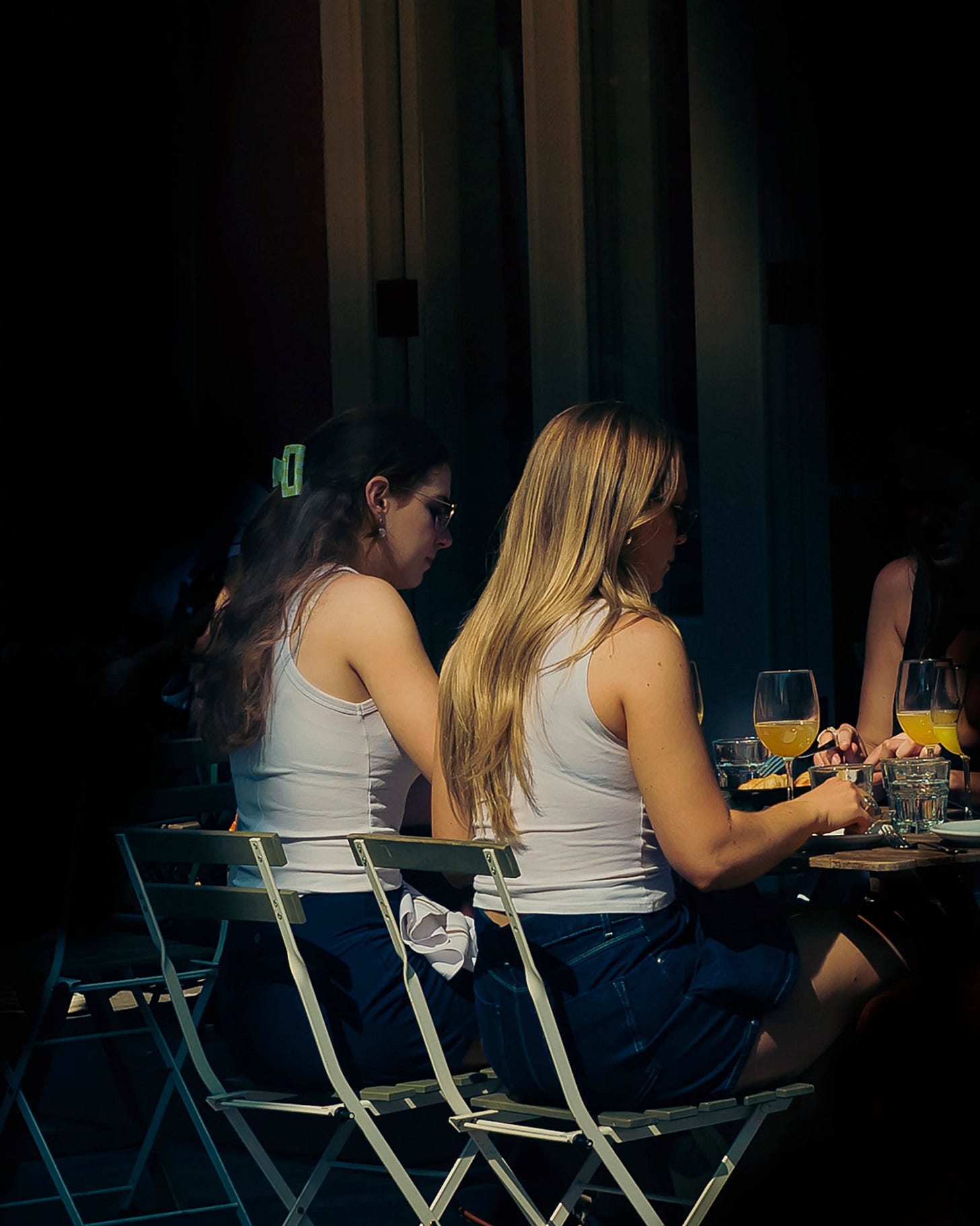
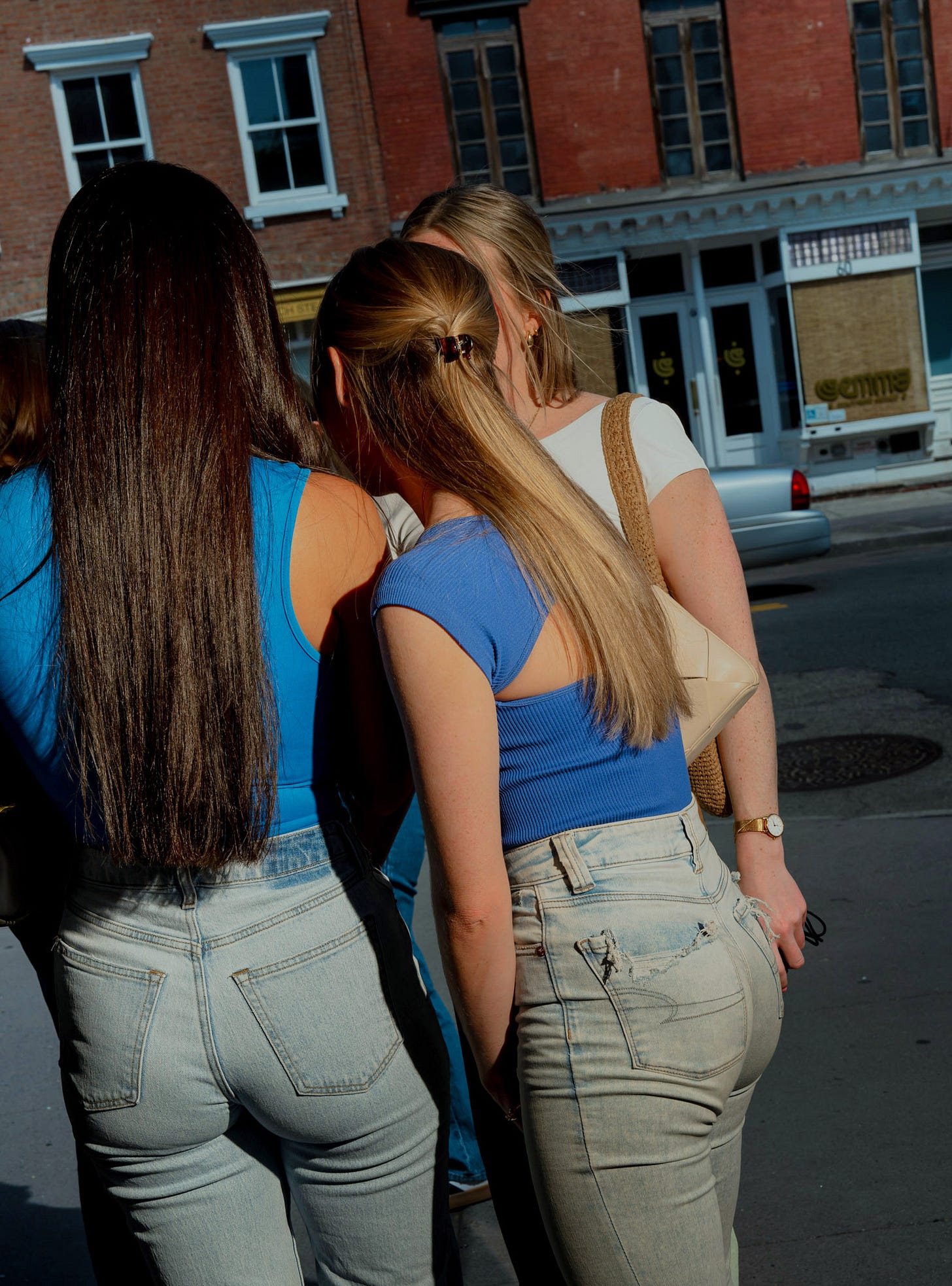
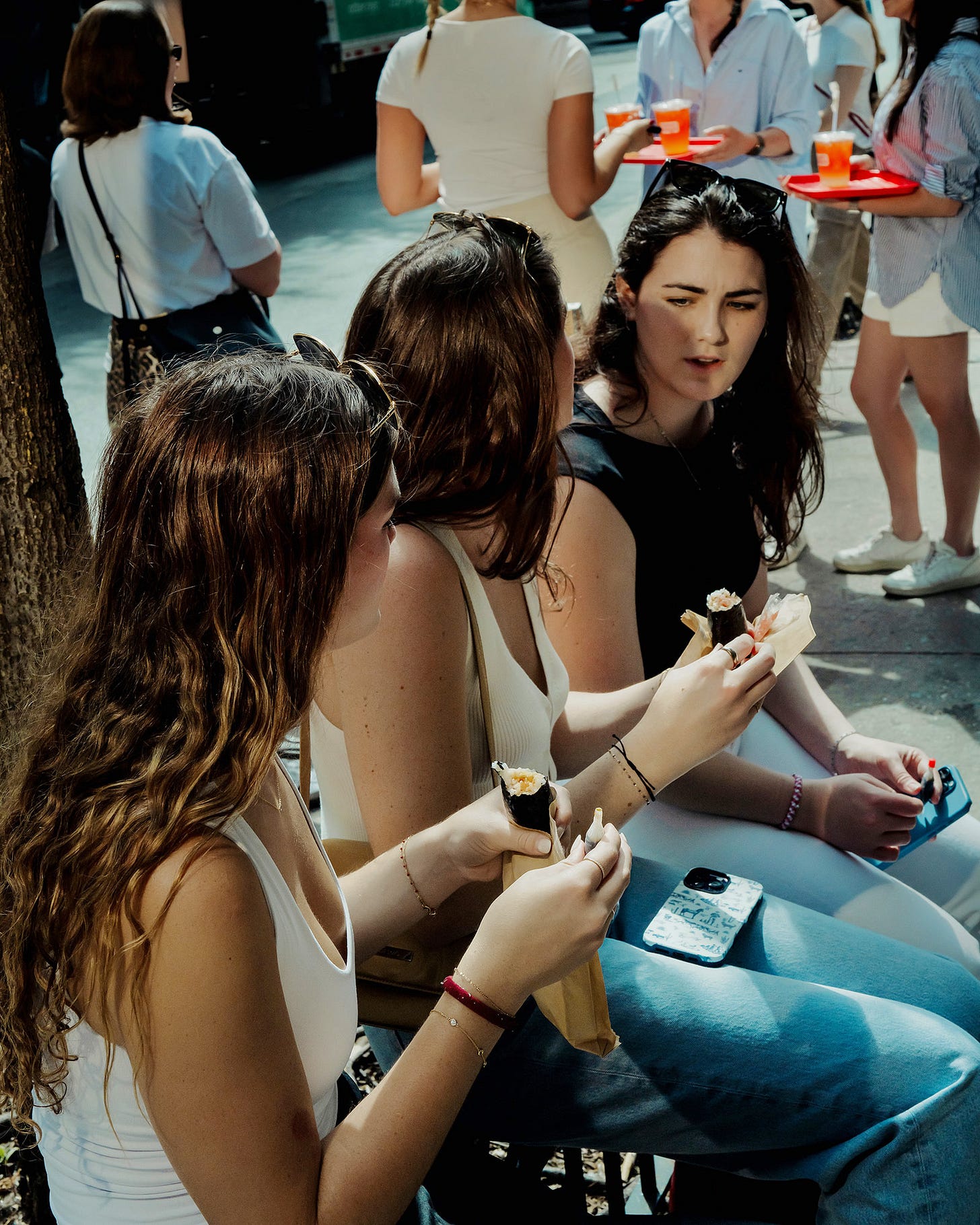
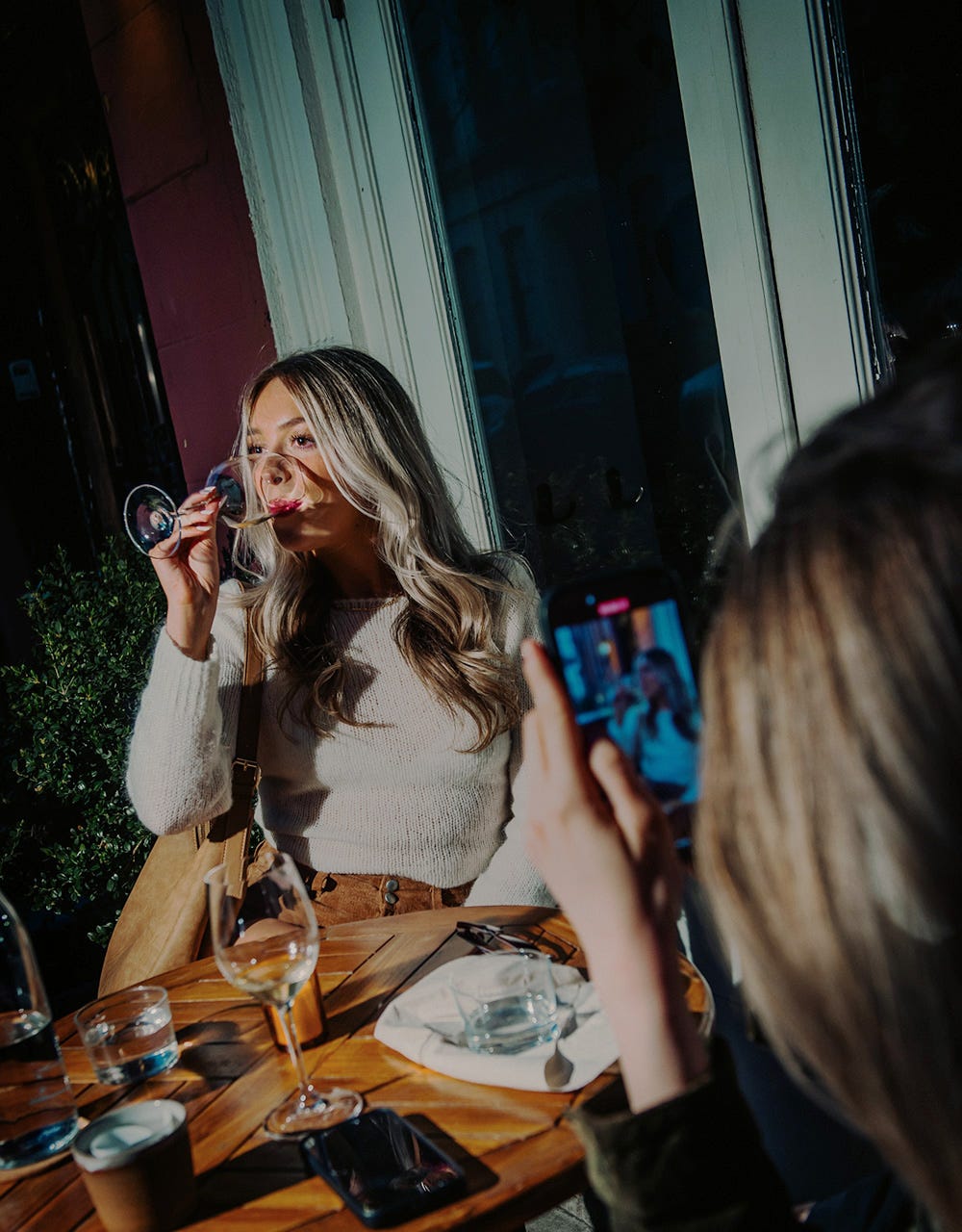
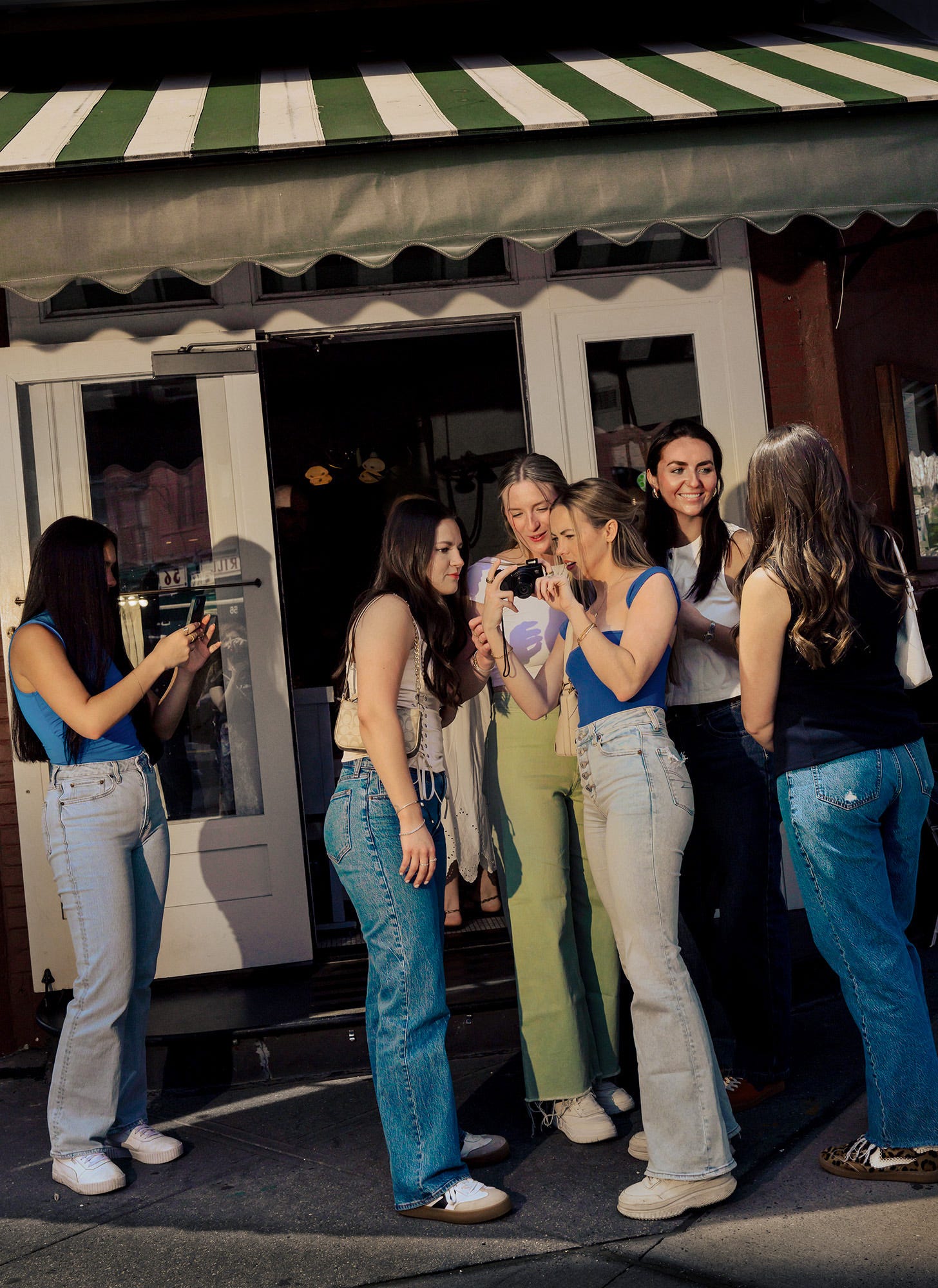
I really loved reading about your process for this piece, how you followed "patterns, the geometry of long, straight hair, and the choreography of blue jeans," while also being mindful of "the amount of criticism they could receive from the anonymous and judgmental public." It shows just how much care and intention went into crafting this photo essay.
A lot of the response I’ve seen to the article critiques these girls as “boring”—a take I don’t entirely disagree with, but that also feels laced with a kind of lazy, gendered dismissal. Your framing offers so much more compassion and complexity: “"There is nothing cryptic about the West Village girl...she embodies a version of youth that feels frictionless...she’s mastered the aesthetics of self-presentation without the burden of justification....She is not performing complexity, and in a culture thriving on micro-analysis and virtue signaling, that can read as naive. But it’s a choice. Young women have always been, and will always be, scrutinized for what they do or don’t do, what they wear, and what they say or don’t say."
I wish The Cut had included more of your photos in their piece! And it absolutely made me laugh that some of the girlies were from Hoboken—because of course they were.
l love the gaze of the dog directly at the camera from under the table, between crossed bare legs, and surrounded by hints of the story theme; cowboy boots below and designer accessories on a cafe table above, bedecked with afternoon drinks. Also love the iconic selfie shot that made cover. Mission accomplished!